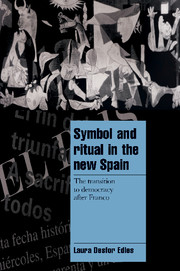Book contents
- Frontmatter
- Contents
- List of tables
- List of figures
- List of abbreviations
- Acknowledgements
- Map of Spain
- Part I Interpreting the Spanish transition to democracy
- Part II The symbolic basis of Spanish consensus
- 4 The spirit of consensus: the core representations of the Spanish transition
- 5 The curtain rises: the first democratic elections
- 6 The 1977 Moncloa Pacts and the ritualization of communality
- Part III Conflict and consensus in the institutionalization of Spanish democracy
- Notes
- References
- Index
4 - The spirit of consensus: the core representations of the Spanish transition
Published online by Cambridge University Press: 06 July 2010
- Frontmatter
- Contents
- List of tables
- List of figures
- List of abbreviations
- Acknowledgements
- Map of Spain
- Part I Interpreting the Spanish transition to democracy
- Part II The symbolic basis of Spanish consensus
- 4 The spirit of consensus: the core representations of the Spanish transition
- 5 The curtain rises: the first democratic elections
- 6 The 1977 Moncloa Pacts and the ritualization of communality
- Part III Conflict and consensus in the institutionalization of Spanish democracy
- Notes
- References
- Index
Summary
The spirit of the Spanish “politics of consensus” was rooted in four core intertwined symbols: “a new beginning” of “democracy” and “national reconciliation” and their symbolic opposite, (profane) “Civil War.” These core symbols are illustrated in Figure 4.1. As discussed in chapter 2 (pp. 20–21), this “cultural map” illuminates the central cultural pattern, or basic conceptual arena, of the transition. These core symbols are linked to, but not at all the same as, shared “values.” Symbols (unlike “values”) are multivocal and contingent; symbols can be manipulated, reworked, and interchanged. The term “representation” is often used synonomously with “symbol.” However, as reflected in Table 4.1, “representation” refers not only to symbols, but ritual processes and events (e.g. the first democratic elections). Thus “representation” is more inclusive than “symbol”; and it reflects the process of perception and cognition (or “symbolization”). As we will see, these four intertwined symbols were the basis of both the strategic ground rules of the politics of consensus, and the ritual process of the Spanish transition (see Table 4.1).
The new beginning
Times of crisis are opportunities to reaffirm as well as to rethink and reformulate fundamental values. This generalization away from the specificity of everyday life often takes the form of expressions of a new temporality. Hunt, for example, points out the centrality of symbols of “rebirth” in the French Revolution. Turner describes the state of liminality that exists during transitional periods as a “moment in and out of time.”
- Type
- Chapter
- Information
- Symbol and Ritual in the New SpainThe Transition to Democracy after Franco, pp. 41 - 62Publisher: Cambridge University PressPrint publication year: 1998

